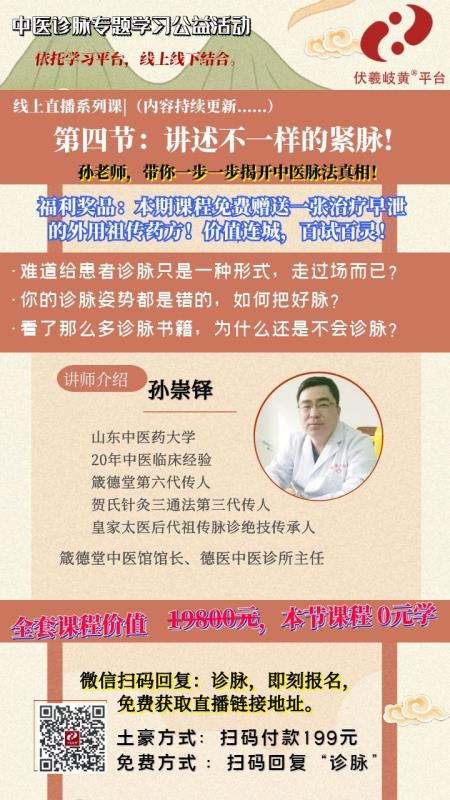Traditional Chinese Medicine Diagnosis – Pulse Diagnosis
Everyone is familiar with pulse diagnosis. Whenever we visit a TCM practitioner, they will check our pulse and can understand our health condition through it. Many people are curious about how TCM can determine our physical condition just by feeling the pulse. Today, let’s learn about what pulse diagnosis in TCM is.

Pulse diagnosis is a method of diagnosis that involves feeling the pulse at different parts of the body to observe the changes in the pulse quality. It is also known as pulse taking, pulse examination, or pulse pressing.
Pulse diagnosis is one of the four diagnostic methods in TCM (inspection, auscultation, inquiry, and palpation), belonging to palpation, and is an essential objective basis for syndrome differentiation and treatment. Palpation is a diagnostic method gradually formed by the Chinese people in their long struggle against diseases. Although it is the last of the four diagnostic methods, it is the most characteristic of TCM, being the only important diagnostic method that directly touches the patient’s body. Its long history, rich content, and extensive literature make it incomparable to the other three diagnostic methods.
The formation of pulse quality is closely related to the zang-fu organs (脏腑) and qi and blood (气血). If there are changes in the zang-fu organs’ qi and blood, the circulation of blood and pulse will be affected, leading to changes in pulse quality.
In clinical practice, pulse diagnosis can infer the progress and prognosis of diseases (疾病的进退预后). Clinically, it is essential to master the timing of pulse diagnosis, the patient’s position, the physician’s finger technique and pressure, and the duration of each pulse check, with each side’s pulse beating at least 50 times. It is also necessary to understand the variations in pulse quality in healthy individuals to conduct accurate pulse diagnosis.

Pulse Diagnosis
【Objectives】
1. Master the method of pulse diagnosis at the cun (寸口) position, the characteristics of normal pulse quality, and the common pulse qualities (浮, 沉, 迟, 数, 实, 洪, 细, 弦, 紧, 滑, 涩, 濡, 缓, 弱, 微, 促, 结, 代) and their clinical significance, as well as the combination of pulse qualities and the main disease patterns. Be able to identify common pulse qualities (浮, 沉, 迟, 数, 洪, 细, 弦, 滑, 弱, 促, 结, 代, etc.) in clinical practice.
2. Familiarize with the principles of pulse diagnosis and its significance, the physiological variations of pulse quality, and the characteristics and clinical significance of long, short, hard, soft, hidden, scattered, moving, and rapid pulses, as well as the special considerations for diagnosing women’s and children’s pulses.
3. Understand the pulse diagnosis methods of the comprehensive examination (遍诊法) and the three positions diagnosis (三部诊法), the clinical significance of the true zang pulse characteristics, and the research progress in pulse diagnosis.
【Meaning】
Pulse diagnosis is a method where the physician uses their fingers to press on the patient’s arteries, observing the pulse response (脉动应指的形象) to understand health or illness and differentiate diseases.
Pulse diagnosis relies on the sensitive touch of the fingers for experience and recognition. Therefore, learning pulse diagnosis requires familiarity with the basic knowledge of pulse theory and mastery of the basic skills of pulse taking, with repeated practice and careful observation to gradually recognize various pulse qualities and effectively apply them in clinical practice.
Section 2: Locations and Methods of Pulse Diagnosis
Yesterday, we learned that the main locations for pulse diagnosis include the cun position diagnosis (寸口诊法), three positions nine pulses diagnosis (三部九候诊法), renying cun position diagnosis (人迎寸口诊法), and Zhang Zhongjing’s three positions diagnosis (仲景的三部诊法). The latter three diagnostic methods have been replaced by the cun position diagnosis method due to their complexity, making the cun position diagnosis method the primary method of pulse diagnosis in modern TCM.
Today, we will learn about the methods of pulse diagnosis:
2. Methods of Pulse Diagnosis
(1) Finger Techniques
When first learning pulse diagnosis, we require each practitioner to examine the pulse quality from the outer side of the patient. Use the left hand to examine the right hand and the right hand to examine the left hand.
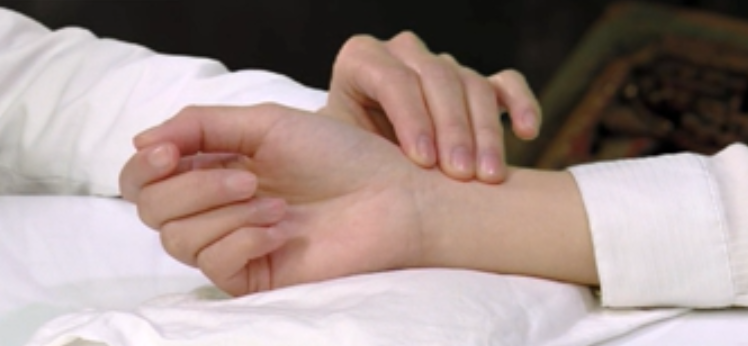
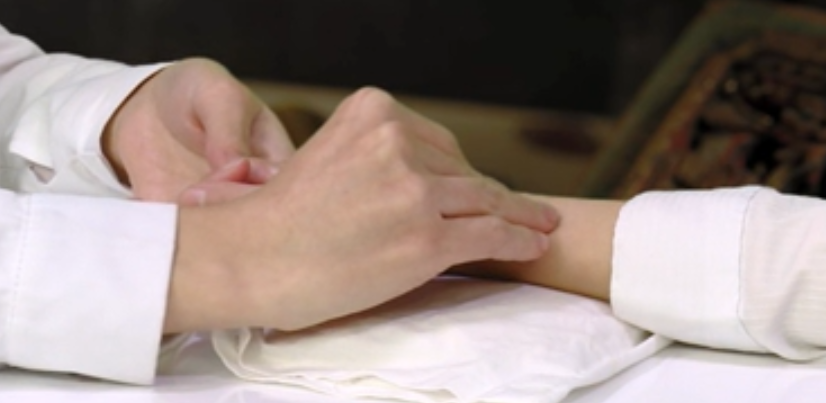
When examining your own pulse, do it the same way:
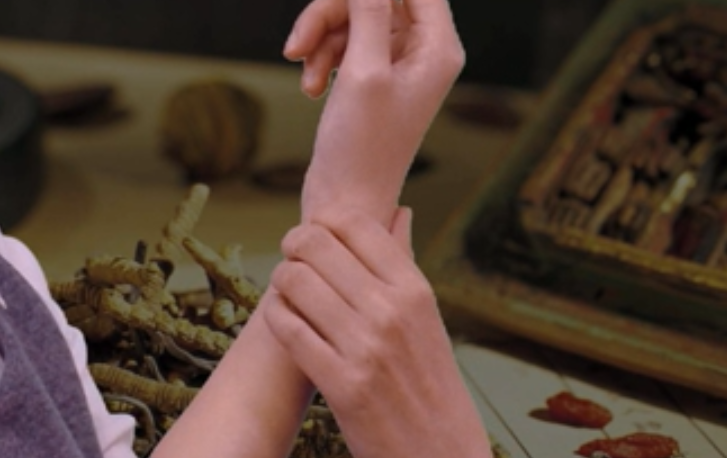
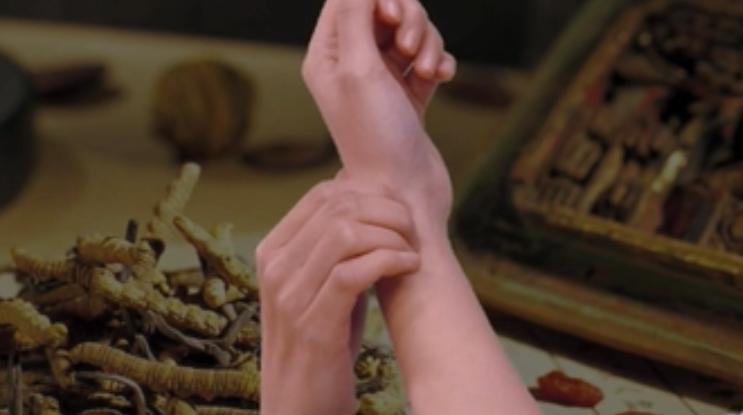
Try to avoid using one hand for diagnosis; if necessary, the practitioner should use both hands to examine the pulse of both hands of the patient.
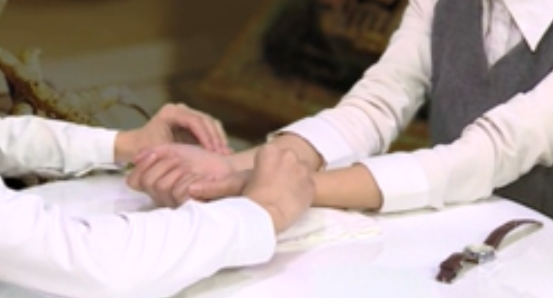
Additionally, when the practitioner uses the index, middle, and ring fingers to examine the pulse, the thumb should ideally press on the back of the patient’s hand to allow the three fingers to apply pressure effectively.
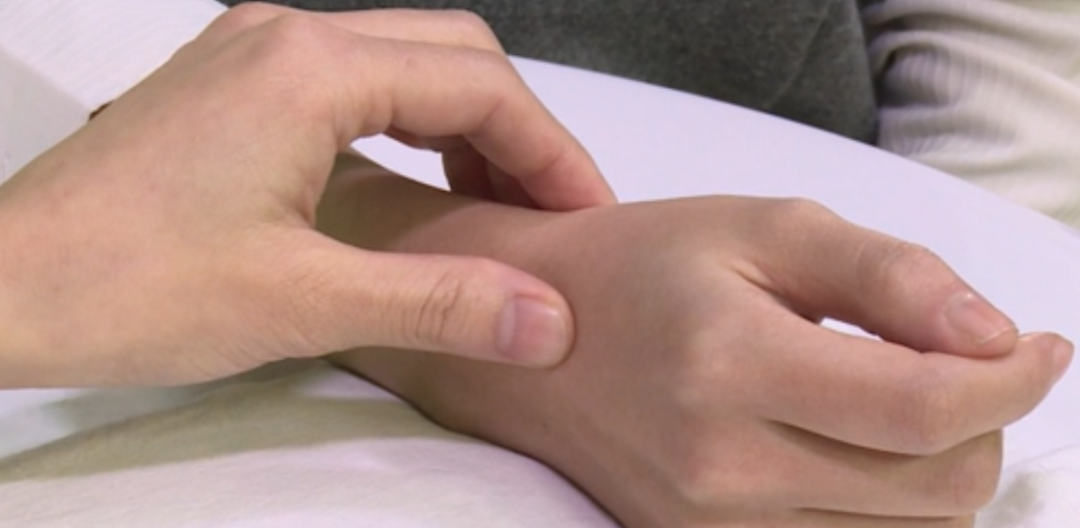
1. The key points of pulse diagnosis finger techniques can be summarized as: three fingers aligned, middle finger positioned correctly, fingers pressing on the pulse ridge, and appropriate finger spacing.
Pressing on the pulse ridge means using the most sensitive part of the fingers, the fingertip, to press on the most prominent pulse point.
The spacing of the fingers refers to the appropriate distance between the fingers during pulse taking, which should correspond to the length of the patient’s arm and the thickness of the physician’s fingers. If the patient’s arm is long or the physician’s fingers are thin, the spacing should be wider. Conversely, if the patient’s arm is short or the physician’s fingers are thick, the spacing should be closer.
For children, the cun position is very short, and generally, the one finger three positions method (一指定三关法) is used without needing to subdivide into cun, guan, and chi. It is important that the middle finger is accurately positioned, as if it is not, it may occupy the position of the ring finger, leading to a false impression of no pulse in that area.
Fingertip — the junction of the fingertip and the finger pad (the most sensitive part of the finger).
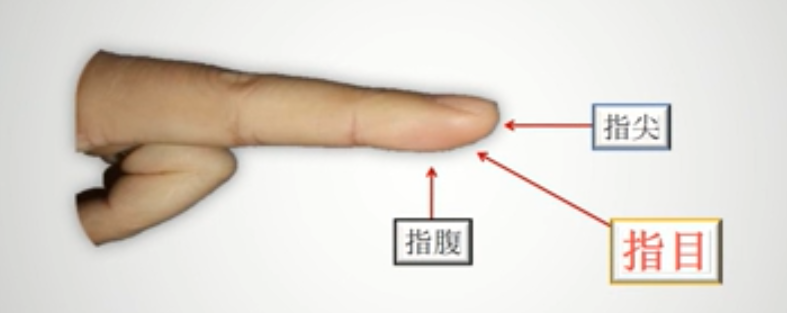
2. Commonly used finger techniques:
① Raising method — using light pressure to feel the pulse (for floating pulse)
② Pressing method — using heavier pressure to feel the pulse (for sinking pulse)
③ Searching method — to seek and explore (for moderate pulse) where the fingers move from light to heavy and back, searching for the most prominent pulse point and adjusting the pressure accordingly.
④ Following method — moving along the axis of the pulse to feel the length and strength of the pulse.
⑤ Pushing method — pressing on the pulse ridge with the fingertip and gently pushing in and out.
⑥ Overall pressing — using all three fingers simultaneously to assess the pulse quality.
⑦ Single diagnosis — using one finger to examine a specific pulse quality at the cun, guan, or chi positions.
During clinical pulse diagnosis, generally, equal pressure is applied by all three fingers, but it is also possible to vary the pressure among the three fingers, combining overall pressing and single diagnosis to comprehensively capture pulse quality information.
(2) Calming and Positioning
1. The meaning of “calming”: The physician should maintain a calm and even breathing while diagnosing the pulse. This allows the physician to count the pulse beats (using their own breathing to count the patient’s pulse) and helps focus their thoughts.
2. Calming count: Four to five beats per breath, meaning that during a normal inhalation and exhalation, the pulse beats should be four to five times.
Let’s see if this judgment is accurate:
Normal breathing is about 16 to 18 times per minute. If we take four to five beats per breath, multiplying 16 by 4 and 18 by 5 gives us 64 to 90 beats, which is very close to the normal pulse rate of 60 to 90 beats per minute. Therefore, when we do not have a watch or clock to count time, we can use our normal breathing to estimate the pulse rate.
3. Positioning: Sitting upright or lying supine — keeping the arm at the cun position level with the heart, wrist straight, and palm facing up.
Note: Watches and jewelry on the wrist should be removed, the forearm should be naturally extended forward, the wrist straightened, the thumb up, and the fingers slightly bent.
(3) Timing of Pulse Diagnosis
1. The meaning of “diagnosis is best done at dawn”: The best time for pulse diagnosis is early morning (dawn) before getting out of bed and before eating. At this time, the body’s qi and blood are balanced, and the internal and external environments are stable, allowing the pulse quality to reflect physiological and pathological conditions more accurately. A quiet environment is optimal.
2. Generally, each pulse diagnosis session should last at least 1 minute per hand, and at least 3 minutes for both hands.
The Neijing states: “The meridians are the pathways that can determine life and death, and treat all diseases; they must be unobstructed.” This means that pulse diagnosis can determine the patient’s life and death, manage all diseases, and regulate deficiency and excess.
The Neijing also states: “A good diagnostician observes color and presses the pulse, … observing the balance and rules to know the main disease, pressing the cun, guan, and chi to understand the cause of the disease.” This means that from the balance of pulse quality, one can identify the main organ affected by the disease; from the patient’s pulse quality, one can discern the cause of the disease.
The pulse is part of the whole, so changes in pulse quality can indicate internal changes. The saying “what is within must manifest without” means that internal changes in the body will be reflected externally.
Pulse diagnosis is a unique diagnostic method created by ancient Chinese medical practitioners. In modern times, Western medicine tends to use stethoscopes, while for over two thousand years, TCM has relied on pulse diagnosis, using fingers to press the pulse and diagnose diseases based on pulse quality. This system of TCM is unique to the world; how much have you learned about it?
